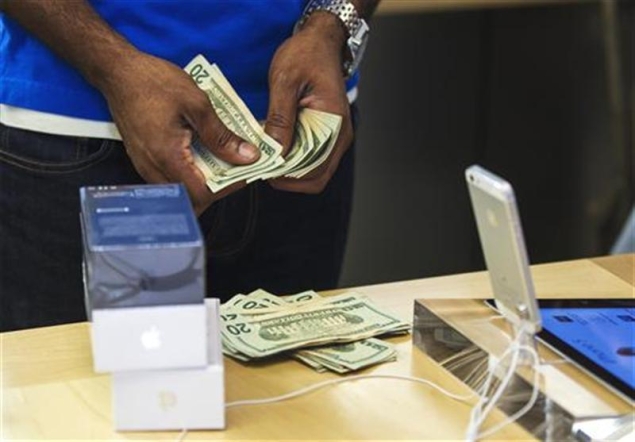- Home
- Mobiles
- Mobiles News
- Investors brace for stock volatility on Apple earnings
Investors brace for stock volatility on Apple earnings

Options pricing on Friday suggested a post-earnings move of about 7.5 percent by April 26. That is far more than in the past and reflects the fact that Apple stock has become more volatile.
The company, once the world's largest by market value, saw its shares close below $400 on Thursday for the first time since December 2011. It has shed nearly $300 billion in market value since peaking at $705.07 a share in September.
"Being a bear on Apple used to be a lonely position. The tables have turned," said Enis Taner, global macro editor at options research firm RiskReversal.com in New York.
A 7.5 percent swing for Apple would be the fourth largest one-day post-earnings move in the last five years, according to research firm Birinyi Associates. That could take shares as high as $419.20 or as low as $360.80, based on the weekly $390 "straddle" expiring on April 26, which cost $29.20 on Friday.
Traders use prices on the straddle to estimate the market's view of the potential range of a stock going into an event such as earnings. A straddle combines the purchase of a call option and put option with the same strike price and expiration date.
A move of 7.5 percent would exceed the average move in Apple after its earnings, which in the last eight quarters has been 5.4 percent. Apple's biggest post-earnings swing was a 12.4 percent drop on January 23 of this year.
Apple is expected to report an 8 percent increase in quarterly revenue, among the weakest displays of quarterly growth in years, according to estimates. Earnings per share are expected to fall 18 percent as Samsung Electronics Co Ltd <005930.KS> and other rivals erode market share for phones and tablets and put downward pressure on margins.
Because the stock was such a stalwart, investors for years knew it was difficult to go against the crowd. Between July 2009 and November 2012, short interest - the percentage of shares borrowed by investors who "short," or bet against, the stock - on Apple never exceeded two percent of the company's shares outstanding. At the current 2.1 percent, Apple's short interest is still lower than 55 percent of U.S. companies, according to Thomson Reuters Starmine.
Expectations of how much the stock is likely to move in coming weeks have also increased. Apple options show implied volatility for the next 30 days was 43.5 percent on Friday, according to data from options analytics firm Livevol.
That implies about a 4 percent move in the stock in either direction in the next month, said Livevol managing director Ophir Gottlieb.
Historic volatility for Apple for the 30-day period over the past year was about 34 percent. It has been rising over the past several months.
Many analysts still expect the stock to rebound because of still-strong demand for Apple's products. But there are many institutions that own shares bought at higher prices and they might remain a source of selling pressure if buyers surface, said Phil Erlanger, president of institutional research firm Phil Erlanger Research in Acton, Massachusetts.
"The problem for Apple is that those that have hung onto their shares after September will represent significant supply, which tends to squash any short-term advance," Erlanger said.
Apple is currently trading at nine times trailing earnings and 45 of 58 analysts polled by Reuters give the stock a "strong buy" or "buy" rating. According to Thomson Reuters Starmine, Apple's intrinsic value - a price target based on expected growth rates over the next decade was about $565 a share.
The stock closed 0.4 percent lower on Friday at $390.53.
© Thomson Reuters 2013
Get your daily dose of tech news, reviews, and insights, in under 80 characters on Gadgets 360 Turbo. Connect with fellow tech lovers on our Forum. Follow us on X, Facebook, WhatsApp, Threads and Google News for instant updates. Catch all the action on our YouTube channel.
Related Stories
- Samsung Galaxy Unpacked 2025
- ChatGPT
- Redmi Note 14 Pro+
- iPhone 16
- Apple Vision Pro
- Oneplus 12
- OnePlus Nord CE 3 Lite 5G
- iPhone 13
- Xiaomi 14 Pro
- Oppo Find N3
- Tecno Spark Go (2023)
- Realme V30
- Best Phones Under 25000
- Samsung Galaxy S24 Series
- Cryptocurrency
- iQoo 12
- Samsung Galaxy S24 Ultra
- Giottus
- Samsung Galaxy Z Flip 5
- Apple 'Scary Fast'
- Housefull 5
- GoPro Hero 12 Black Review
- Invincible Season 2
- JioGlass
- HD Ready TV
- Laptop Under 50000
- Smartwatch Under 10000
- Latest Mobile Phones
- Compare Phones
- Huawei Nova 15
- Huawei Nova 15 Pro
- Huawei Nova 15 Ultra
- OnePlus 15R
- Realme Narzo 90x 5G
- Realme Narzo 90 5G
- Vivo S50 Pro Mini
- Vivo S50
- Asus ProArt P16
- MacBook Pro 14-inch (M5, 2025)
- Huawei MatePad 11.5 (2026)
- OnePlus Pad Go 2 (5G)
- OnePlus Watch Lite
- Just Corseca Skywatch Pro
- Acerpure Nitro Z Series 100-inch QLED TV
- Samsung 43 Inch LED Ultra HD (4K) Smart TV (UA43UE81AFULXL)
- Asus ROG Ally
- Nintendo Switch Lite
- Haier 1.6 Ton 5 Star Inverter Split AC (HSU19G-MZAID5BN-INV)
- Haier 1.6 Ton 5 Star Inverter Split AC (HSU19G-MZAIM5BN-INV)

















